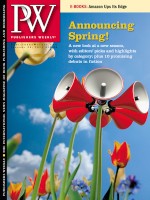While all the big box stores carry books and all offer discounted bestsellers, Target competes most directly for those consumers who might otherwise make their purchases at bookstores. Of all the big box stores, the Minnesota-based company's shoppers align most closely with the demographics of U.S. book buyers. Target's selection of both trade fiction and nonfiction, plus a smattering of mass market releases in its 1,750 stores in 49 states overlaps with the offerings one would expect to find at a typical general bookstore.
"They look at books as merchandise, but, at the same time, they don't see themselves in competition with Wal-Mart or K-Mart," says one Midwestern sales rep, who has called on Target for approximately 25 years. "They see themselves in competition with Barnes & Noble." This assertion makes sense, especially considering that Target doesn't just stock books, Kindles, and Sony readers: it promotes its own book club picks and "Bookmarked Breakout" releases by emerging authors, similar to B&N's "Discover Great New Writers" program, and occasionally offers exclusive items, such as special editions of select titles.
Customers of the retailer are younger and more affluent than those at typical discount department store chains; 30% of the latter are older than 65 years and 55% have a household income below $40,000. According to Target, 80%–90% of its customers are female, with a median age of 46; 83% have children at home. Almost half have completed college, and more than half are employed in professional or managerial positions. The median household income of Target's customers is $55,000. According to a Bowker PubTrack survey of consumer book-buying behavior, in the third quarter of 2010 80% of Target customers who bought a book were women, with 62% of buyers coming from households with income over $50,000. Buyers spent the most money on fiction titles, with fiction accounting for 51% of spending, followed by children's books, which took 31%. Nonfiction represented only 10% of spending.
Although Target releases little information on its own about its book operations, corporate spokesperson Tara Schlosser says that Target "aims to offer a broad-appealing assortment" of titles after taking into consideration exactly who their customers are and why they shop at Target. The company strives to offer a "balance of the newest content, bestsellers, seasonal and age-appropriate content" for "all occasions and at all stages" of the lives of customers and their families. Target stores sell all books at a discount, typically 15%–30%, and on Target.com, all 340,841 items listed in the book department are discounted between 5% and 30%, with free shipping for orders over $50.
Buying decisions for the books are made at corporate headquarters in Minneapolis by a team of buyers who each specialize in a different broad category, such as adult fiction, nonfiction, and children's. Levy Home Entertainment, the distribution company supplying Target and many other national retailers with books, provides input, but the buyers make the final decisions.
While Schlosser stated that Target is "mindful of the regional and cultural differences within specific stores," when PW recently visited a Target store in Duluth, Minn., its book department, which contained about 800 titles, included essentially the same titles as a slightly larger Target store in San Diego that PW also visited. Some titles were displayed differently in each store, however. For instance, while many of the adult titles in both stores would appeal more to female readers, the San Diego store displayed on aisle endcaps both nonfiction books by conservative political pundits and thrillers by authors with more of a male fan base, like James Patterson and Tom Clancy. Children's and YA books were about half of the entire book department in both stores.
According to the publisher's rep PW interviewed, the company considers itself a "trend merchant" above all else. He says that the company buys up to 50 new fiction titles each month, focusing on those offerings from the big houses with print runs above 100,000 copies and promotional budgets to match.
"They're not as concerned with the overall literary value of a book as they are that it sells," the rep notes. Tinkers, for example, published to critical acclaim but little fanfare in January 2009 by Bellevue Literary Press, was not stocked in Target stores until after Harding won the Pulitzer Prize. There currently are 350,000 copies of Tinker in print, with more than 20,000 sold through Target since last spring.



 Volume 258
Issue 04
01/24/2011
Volume 258
Issue 04
01/24/2011





